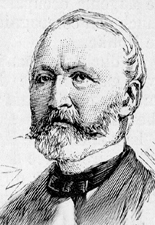
Jean II de Rieux (1342 - 1417) Breton Lord of Rieux, Rochefort and Ancenis, initially in the service of Brittany, but also eventually a Marshal of France in the service of King Charles VI. He was the great-grandfather of Jean IV de Rieux.

Jean II de Rieux (1342 - 1417) Breton Lord of Rieux, Rochefort and Ancenis, initially in the service of Brittany, but also eventually a Marshal of France in the service of King Charles VI. He was the great-grandfather of Jean IV de Rieux.
Jean fought under the command of the English Edward the Black Prince, participating in the Battle of Nájera (1367), against the French led by Bertrand du Guesclin. Although the English won the battle, the Black Prince went bankrupt.
He was one of the signatories of the second Treaty of Guérande in 1381 as a representative for the Duke of Brittany John IV. [1] The Duke had restored his rights and agreed to make a small tribute to the King Charles VI. Furthermore, Brittany would stay neutral in continuing military conflicts between France and England.
Jean then offered his services to France. In 1382 he fought at the Battle of Roosebeke. In 1397 De Rieux was appointed as Marshal of France.
In 1405 he was sent to Wales to help the Welsh with the Glyndŵr Rising. He had left Brest in July with more than 3,000 knights and men-at-arms. Unfortunately, the army had not been provided with sufficient fresh water and many warhorses had died. He did though bring modern siege equipment. Joined by Owain Glyndŵr's forces the French marched inland and took the town of Haverfordwest but failed to take the castle. He then marched on England, but the result of this expedition was not successful.
His age and the injuries that he had received over the years eventually prevented him from performing his duties. He was, at his request, relieved from his duties at 12 August 1417. He died the same year in his castle at Rochefort, where he was buried.

Louis Moréri was a French priest and encyclopedist.

Rennes-les-Bains is a commune in the Aude department in southern France.

The House of Rohan is a Breton family of viscounts, later dukes and princes in the French nobility, coming from the locality of Rohan in Brittany. Their line descends from the viscounts of Porhoët and is said to trace back to the legendary Conan Meriadoc. Through the Porhoët family, the Rohans are related to the Dukes of Brittany, with whom the family intermingled again after its inception. During the Middle Ages, it was one of the most powerful families in the Duchy of Brittany. The Rohans developed ties with the French and English royal houses as well, and they played an important role in French and European history.

Count Toussaint-Guillaume Picquet de la Motte, also known as La Motte-Picquet was a French Navy officer and admiral. Over a career spanning 50 years, he served under Louis XV and Louis XVI and took part in 34 campaigns. He fought in the Seven Years' War and in the Naval battles of the American Revolutionary War, earning the ranks of Commandeur in the Order of Saint Louis in 1780, and of Grand Cross in 1784. He died during the French Revolution.
Comte Antoine-François Bertrand de Molleville was a French politician.
Bernard Le Nail was a French writer and Breton militant. After studying commerce in Paris, he headed the promotional office of the Chamber of Commerce and Industry in Nantes. In 1979 he became Secretary General of the Comité d'Etude et de Liaison des Intérêts Bretons (CELIB) at Lanester. Between 1983 and 2000 he was director of the Cultural Institute of Brittany and had an important role in the conception and publication of the collection Les Bretons au-delà des mers : Explorateurs et grands voyageurs. He was also involved in the conception and publication of the following works: 500 Bretons à connaître, revising the Guide Bleu Bretagne, Guides Gallimard Bretagne, Les noms qui ont fait l’histoire de Bretagne, Dictionnaire des femmes en Bretagne, La Bretagne entre Armor et Argoat.

The Battle of Saint-Aubin-du-Cormier took place on 28 July 1488, between the forces of King Charles VIII of France, and those of Francis II, Duke of Brittany, and his allies. The defeat of the latter signalled the end to the "guerre folle", a feudal conflict in which French aristocrats revolted against royal power during the regency of Anne de Beaujeu. It also effectively precipitated the end of the independence of Brittany from France.

François d'Andelot de Coligny was one of the leaders of French Protestantism during the French Wars of Religion. The son of Gaspard I de Coligny, he was the younger brother of Odet, cardinal de Châtillon and Gaspard de Coligny the admiral.

Arthur Le Moyne de La Borderie, was a Breton historian, regarded as a father of Brittany's historiography.

Antoine-Jacques Roustan was a Genevan pastor and theologian, who engaged in an extensive correspondence with Jean-Jacques Rousseau. Unlike Rousseau, he believed that a Christian republic was practical - that the Christian religion was not incompatible with patriotism or republicanism.
Auguste Julien Marie Lorieux, was a 19th-century French writer and jurisdiction consultant.
The du Quenoy family is a French noble house of medieval and chivalric lineage. Its origins are in Normandy. The family was first mentioned in a Papal Bull issued by Pope Alexander III, dated May 17, 1181, to acknowledge its endowment of the Priory of Saint-Lô du Bourgachard. Initially seigneurs and chevaliers, the family was raised to a barony by King Louis XIII in August 1636. The family produced generations of feudal lords, army officers, and numerous knights of royal orders. A cadet branch of the family, now extinct, was elevated to the rank of marquis in July 1714.

Alphonse Wauters (1817–1898) was a Belgian archivist and historian.

Pierre-Jean-Baptiste Nougaret was an 18th–19th-century French man of letters. He is the author of over one hundred forty volumes covering the most diverse subjects and in all genres: serious and facetious poems, dramas, parodies, historical compilations, political writings, collections of anas, epistolary novels, novels, memoirs. He is best known for his involvement with Nicolas Edme Restif de La Bretonne, whom he met on his arrival in Paris in 1766. He died 27 June 1823 in Paris, at 4 rue d'Assas, aged eighty.

Bernard de Moreuil was a noble of Picardy, the lord of Moreuil and Cœuvres, and Marshal of France.
Guillaume de Montfort, was a 15th-century French cleric, Bishop of Saint-Malo and cardinal.
Jean Meyer was a French historian who specialised in naval and maritime topics.

Louis Guy Henri, Marquis de Valori, was a French diplomat and aristocrat, who served as a general under Louis XV. He served as French ambassador at the courts of Frederick William I of Prussia and Frederick the Great.

Charles-Ange, Count of La Monneraye was a 19th-century French soldier, historian and politician, who was deputy for Morbihan at the end of the Second Empire and under the nascent Third Republic, then senator of the same department from 1876.
This article includes a list of general references, but it lacks sufficient corresponding inline citations .(May 2019) |